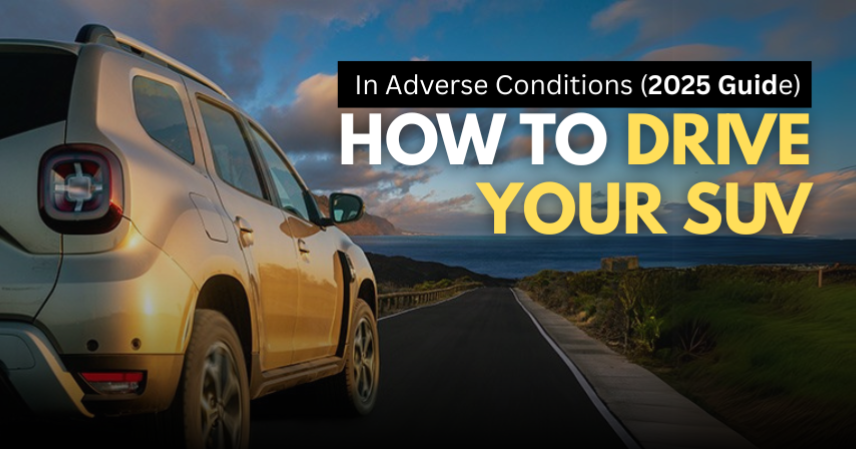From Muddy Trails to Snowy Roads – MasterEvery Terrain Like a Pro
Modern SUVs are built to tackle more than just city streets. Whether you’re driving through a rain-soaked highway or navigating snowy mountain passes, understanding how to handle your SUV in challenging conditions is critical. This guide will equip you with expert tips to confidently manage your vehicle across diverse and adverse driving environments, ensuring both safety and performance.
Key Situations and Expert Tips
1. Driving at Night
- Ensure all headlights and fog lamps are functioning.
- Drive slower than usual to match your visibility range.
- Keep windshields clean for glare-free visibility.
Use high beams responsibly; switch to low beams for oncoming traffic.
2. Driving in Rain
- Check tyre tread depth; replace if worn.
- Avoid sudden braking to prevent hydroplaning.
- Use fog lights if visibility drops.
- Increase the distance between your vehicle and the one ahead.
3. Driving Through Waterlogged Roads
- Confirm water depth before proceeding—never cross if it exceeds half your tyre height.
- Engage low gear and maintain steady throttle to avoid stalling.
- After crossing, tap brakes gently to dry them.
Pro Tip: Avoid overtaking or changing lanes mid-crossing—one mistake could cause water to enter the engine bay.
4. Driving on Sand
- Lower tyre pressure (by 20–30%) to increase surface area and traction.
- Maintain momentum to avoid sinking.
- Engage 4H (High-Range Four-Wheel Drive) mode.
- Avoid sharp turns or sudden stops
5. Driving in Muddy Terrain
- Select an off-road mode (if available) or shift to 4L (Low-Range Four-Wheel Drive).
- Use steady throttle input; avoid wheel spin.
- Carry traction aids or recovery tracks.
- Steer gently—overcorrection can worsen traction.
6. Driving in Snow
- Use snow-rated tyres for maximum grip.
- Shift to higher gears to reduce torque at wheels.
- Maintain slow, steady speeds—avoid sharp braking.
- Keep snow chains in your boot for emergencies.
7. Steep Ascents and Descents
- Engage hill-hold or hill-descent assist features.
- For climbs, maintain momentum; use low gear.
- For descents, use engine braking—avoid riding the brake pedal.
- Keep a safe distance; don’t overtake on inclines.
8. Towing or Recovery Situations
- Use a rated tow rope or recovery strap.
- Coordinate clearly with the assisting driver.
- Avoid jerking motions—build up tension slowly.
- Always tow from manufacturer-approved points.
SUV Driving Safety Essentials
- Regularly inspect tyre pressure and brake condition.
- Keep an emergency kit with a torch, jumper cables, recovery gear, and food supplies.
- Always wear your seatbelt—even off-road.
- Follow manufacturer guidelines on 4×4 usage and terrain modes.
Technology That Helps
Modern SUVs come equipped with advanced driver-assistance systems (ADAS) that enhance safety during adverse conditions:
| Feature | Benefit |
|---|---|
| Hill Descent Control | Maintains controlled speed on steep slopes |
| Traction Control System | Prevents wheel spin in slippery conditions |
| All-Wheel/4×4 Drive Modes | Optimizes torque distribution |
| Electronic Brakeforce Distribution (EBD) | Ensures stable braking |
| 360-Degree Cameras | Enhances visibility on uneven terrain |
Final Thoughts
Mastering your SUV in adverse driving conditions requires a blend of preparation, technical knowledge, and calm execution. Whether it’s the monsoon streets or snowy mountain switchbacks, understanding your SUV’s capabilities—and your own limitations—ensures you stay safe and in control.
If your SUV is equipped with modern off-road and safety technologies, make the most of them. When in doubt, consult your owner’s manual or seek professional guidance.

